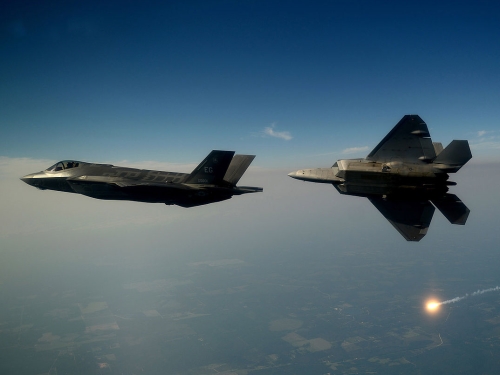
This article was originally published by War on the Rocks on 4 December, 2014.
As the Air Force Times recently reported, the F-22 and F-35A conducted their first integrated training mission earlier this month. Several observers declared this mission, which included offensive counter air, defensive counter air and interdiction operations, to be a success. But if the planes are to actually operate as a cohesive strike package in the complex A2/AD environments of the future, the services will first need to address a glaring gap in interoperability: data links.
Currently, the F-22 and F-35 are equipped with two different low probability-of-intercept/low probability-of-detection (LPI/LPD) systems for exchanging data while in stealth mode: the F-22 uses the older and more limited Intra Flight Data Link (IFDL); the F-35 operates with the newer Multifunction Advanced Data Link. Quite astoundingly, these two LPI/LPD systems cannot communicate with each other, meaning that if the F-35 and F-22 need to share information with each other, they must do so using the non-stealthy Link 16 system used by 4th-generation legacy aircraft. (And even then, the F-22 is limited to receiving data; it cannot transmit it.)
This is particularly problematic because, given the expense of operating both the F-22 and the F-35 in comparison to legacy aircraft, they are — at least in the near-term — likely to be deployed together only when stealth is required. Furthermore, the lack of compatible data links means that the information gathered by the planes’ highly capable sensors and avionics — often described as one of their greatest comparative advantages — cannot be fully leveraged within a 5th-gen strike package, in turn diminishing the potential of integrated targeting capabilities.
The problems do not end there. In addition to the lack of interoperability between the two 5th-generation fighter datalinks, there is also a lack of interoperability between 5th-generation fighter and 4th-generation fighter datalinks. This means that legacy aircraft are not able to maximally benefit from the vastly superior situational awareness and threat detection capabilities of their 5th-generation brethren. As a result, F-35 operators — which in addition to the Air Force will include the U.S. Marine Corps and Navy, as well as a host of foreign governments — cannot realize the full return on unprecedented levels of investment.
Moreover, because the United States did not export the F-22 (and because F-22s can only transmit data to each other), the lack of interoperability also means that the F-22 cannot transmit data to any allied aircraft and can only receive data from those aircraft equipped with the Link 16 system — a capability of dubious utility. (At least one news source has suggested that this deficiency forced the F-22 to sit out the multinational air campaign in Libya, though the relative immaturity of Libyan air defenses — combined with the plane’s high operating costs — likely contributed as well.)
To its credit, the Air Force has made some progress in addressing the cross-generational (“fifth-to-fourth”) datalink issue. It has completed the final design review for Talon HATE, an F-15C communications pod that is equipped with IFDL. Thus, when the initial four-pod Talon HATE lot is fielded in mid-2015, communications between the F-22 and a select number of 4th-generation aircraft will be possible. This milestone will represent an important first step in correcting a major impediment to integrated air operations — particularly those conducted with U.S. allies and partners — but it is one that must be expanded in the years to come.
The Air Force has not, however, made adequate progress in addressing the communications gap between its stealthy fighters — a gap that is arguably far more critical to the future of U.S. air combat power and one that the outgoing chief of the Air Combat Command once described as “appalling.” Indeed, as the Air Force expands integrated training missions and begins incorporating the F-35A into the fleet in 2016, it must accelerate efforts to bridge the communications gap and fully optimize its force. To this end, the Air Force should provide clear timelines and funding guidance to potential industry partners, many of which have already undertaken independent efforts to develop foundational technologies. Given the professed value of stealth in A2/AD environments, as well as the sizable expense of developing both the F-22 and the F-35, it would be a momentous error to forfeit the substantial force multiplying effects provided by interoperable, LPI/LPD datalinks.
Kelley Sayler (@kelleysayler) is a research associate at the Center for a New American Security. Her most recent report, co-authored with Ben FitzGerald, is Creative Disruption: Technology, Strategy, and the Future of the Global Defense Industry.
For more information on issues and events that shape our world, please visit ISN Security Watch or browse our resources.

